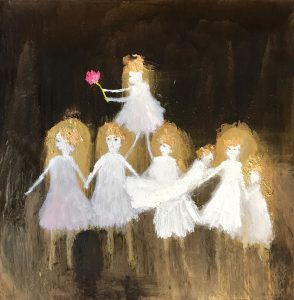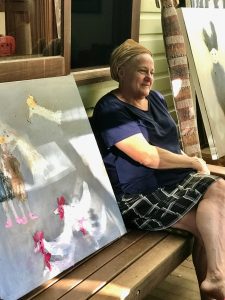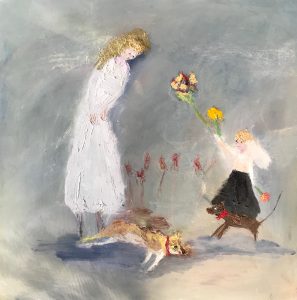

Life is short but art is long’ could be a motto for the latest collection of works from local artist Hilary Herrmann, on exhibition at the Tweed Regional Gallery from this month until the end of August.
Named Keepsakes, the 28 paintings are evidence that art can conquer time, by giving new life to those who have passed away.
The collection is based upon a trunkful of old photographs that Hilary had stored away. When she dug them out to see if they had been affected by the endless weeks of rain last year she says she “stumbled upon memories, vague and half-forgotten. The same faces emerged, places too, known and disremembered. I realised there was no one left to tell me who they were”.
So began a visual conversation, “a filling in of the gaps and the cracks and the shaky in-between places. Maybe an homage, maybe just a keepsake”.
“Keepsakes are things you treasure and want to hold on to, and that’s what memories are: it’s all about memory and forgetting, and all those important things. Otherwise they disappear.”
Her paintings, often described as dreamlike and ephemeral, thus have a robust, real-world purpose and meaning to them, resurrecting the dead, some of them forgotten, some never known, and giving them a permanence, or at least some longevity beyond the grave.
They are gone, lost in time, but Hilary conjures them up again, compensating for frail memory.
“The exhibition has evolved into a beautiful reminder that the memories we keep and revisit provide us with some of the most valuable aspects of life,” says Tina Wilson, the Tweed Gallery’s Exhibitions Curator. “The paintings … tenderly capture significant moments of other people’s lives.”
The photo-based approach is a new one for Hilary, who says she usually begins a piece with an idea or emotion to express. Tina notes that despite the fresh starting point, Hilary “continues to paint with her heart as much as her hand, which is shown through her consideration for the stories of unknown people”.
The memories might be personal, but the subjects often evolve once committed to canvas, made into archetypes or characters in stories Hilary hopes will communicate to others something that is meaningful to them.
 She makes them her own, sometimes from elements she would never normally use, such as an old man with a pram. A photo of her father and another man on a horse became two girls.
She makes them her own, sometimes from elements she would never normally use, such as an old man with a pram. A photo of her father and another man on a horse became two girls.
“I usually use my own language to make it into a story,” she says.
Another photo showed a woman with a bunch of flowers in a field in Hilary’s childhood home of Kenya. She doesn’t know who the person was – perhaps she was one of the German Jews who were accepted into East Africa before World War Two. Among them were Hilary’s parents, who left Kenya during the Mau Mau uprising to come to Australia, refugees twice in their lives.
The paintings have another deeply humane theme running through them, again giving substance to the wispy, whimsical figures depicted, leaping out from the muted shades of the thickly applied oil surfaces, sometimes in a bouquet of brilliant colour or signalled by the gold-leaf crowns adorning the heads of many of her subjects.
It is the endowment of dignity – glory even – shining out of the canvas, expressing the idea that everyone has a specialness about them which deserves to be recognised, and celebrated. “No one wants to be diminished. Everyone wants to be seen. You don’t have to be the star, the show-pony, but we all need to be seen and listened to … and often people aren’t,” Hilary says.
The animals have this dignity too, even the needy chickens, bad tempered ducks and her large and lolloping rescue pup, Shelley.
It is there even in the playfulness, the quirky look of the birds, many of them Hilary’s companions in the forest and farmland that surround her home, which sometimes sit and watch her paint on her deck. The message is: be kind, show compassion; every creature deserves respect. “These qualities are increasingly rare,” she says.
The Tweed show is the biggest that Hilary has had, though her work has shown and sold well for decades in galleries in Sydney and Melbourne, where she has a reputation as an artist of considerable accomplishment. She is, however, impatient with formal constraints. “I don’t obey the rules. It’s about the aesthetic. Sometimes I paint over things 20 or 30 times because it hasn’t got to where I wanted it to be.
“As soon as you make a mark on your canvas or paper, you’re going to have to start to resolve it. Sometimes it’s straightforward and sometimes it’s a curse. I often ruin things because I go too far.”
How a painting finishes up might be nowhere near how she wanted it to be, and she accepts that. She calls it “the intelligence of paint”.
“I like where it takes me. One mark responds to another mark, and because you’ve done that compositionally, it needs this or that …. it’s just muddling along.
“I don’t think painting is any different to life: you start something, it can be full of doubts, sometimes splendour. You just have to trust.”
Digby Hildreth